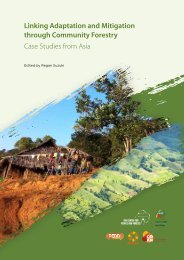Desktop Study on - Regional Climate Change Adaptation ...
Desktop Study on - Regional Climate Change Adaptation ...
Desktop Study on - Regional Climate Change Adaptation ...
You also want an ePaper? Increase the reach of your titles
YUMPU automatically turns print PDFs into web optimized ePapers that Google loves.
Assessment of Capacity Gaps and Needs of South East Asia Countries<br />
in Addressing Impacts, Vulnerability and Adaptati<strong>on</strong> to <strong>Climate</strong> Variability and <strong>Climate</strong> <strong>Change</strong><br />
droughts have resulted in the delay or cancellati<strong>on</strong><br />
of the paddy planting seas<strong>on</strong>. During such occasi<strong>on</strong>s,<br />
the paddy farmers whose livelihood depends mainly<br />
<strong>on</strong> paddy cultivati<strong>on</strong> would be seriously affected.<br />
As for the whole country, the impact of drought<br />
<strong>on</strong> food producti<strong>on</strong> can be very serious, given that<br />
there are about 322,000 hectare of irrigated paddy<br />
fields and another 278,000 hectare of rain-fed paddy<br />
fields producing about 2.5 milli<strong>on</strong> t<strong>on</strong>nes of paddy<br />
per annum. DID, in fact, is very c<strong>on</strong>cerned with the<br />
supply of water for irrigati<strong>on</strong>, especially for small<br />
irrigati<strong>on</strong> schemes, during a drought. This is because<br />
about 70 % of the total water c<strong>on</strong>sumpti<strong>on</strong> in this<br />
country is utilized for irrigated agriculture (Husaini,<br />
2007).<br />
Other impact is related with sea level rise; the nati<strong>on</strong>wide<br />
loss of about 80,000 ha of land planted with<br />
rubber due to flooding as a result of the combinati<strong>on</strong><br />
of increased rainfall and sea level rise of 1 m; also the<br />
aband<strong>on</strong>ment of about 100,000 ha of land planted<br />
with oil palm in the event of a 1 m rise in sea level<br />
(MOSTE, 2000).<br />
Vulnerability and Adaptati<strong>on</strong> in the<br />
Agricultural and Food Sector<br />
Vulnerability is defined in terms of yield, farm<br />
profitability, regi<strong>on</strong>al ec<strong>on</strong>omy and hunger<br />
c<strong>on</strong>sidering uncertainty about future climatechange<br />
impacts. According to the projecti<strong>on</strong>, in the<br />
l<strong>on</strong>g term, climate change is an additi<strong>on</strong>al problem<br />
that agriculture faces in meeting nati<strong>on</strong>al food<br />
requirements. Since it is likely that some climate<br />
change will occur over the next 50-100 years,<br />
‘adaptati<strong>on</strong>’ has been suggested as the means to<br />
reduce the impact of climate change <strong>on</strong> individuals<br />
and societies (Siwar et al, 2009).<br />
In Malaysia there are some nati<strong>on</strong>al policies<br />
regarding adaptati<strong>on</strong> and mitigati<strong>on</strong> to climate<br />
change, but also specific adaptati<strong>on</strong> measures<br />
are necessary to manage sectoral impacts. In the<br />
agriculture sector, adaptati<strong>on</strong> measures are vital to<br />
ensure sustainability of the agriculture activities.<br />
These measures include (Kamal, 2007):<br />
The use of agro-climatic classificati<strong>on</strong> in<br />
agricultural planning: The Department of<br />
Agriculture drafted an agro-climatic map of<br />
Peninsular Malaysia based <strong>on</strong> the agriculture<br />
rainfall index (ARI) in 1990. Ten agro-climatic<br />
z<strong>on</strong>es were identified according to the number<br />
of c<strong>on</strong>secutive dry and c<strong>on</strong>secutive wet<br />
m<strong>on</strong>ths. The agro-climatic maps defined the<br />
various regi<strong>on</strong>s according to the variati<strong>on</strong>s in<br />
envir<strong>on</strong>mental requirements of different crops<br />
as well as <strong>on</strong> the regi<strong>on</strong>al differences of the<br />
natural envir<strong>on</strong>ment, particularly climate and<br />
soils.<br />
The use of Soil Suitability Criteria for crop<br />
producti<strong>on</strong>: Physical and chemical properties<br />
of the soil affect crop producti<strong>on</strong>. Soil depth,<br />
texture, clay fracti<strong>on</strong>, soil structure, bulk<br />
density and available soil moisture are am<strong>on</strong>g<br />
the major soil physical properties that affect<br />
crop producti<strong>on</strong>. Soil reacti<strong>on</strong>, cati<strong>on</strong> exchange<br />
capacity and nutrient compositi<strong>on</strong> are the<br />
soil chemical properties, important in crop<br />
producti<strong>on</strong>. By c<strong>on</strong>sidering these properties<br />
in soil suitability classificati<strong>on</strong>, the success of<br />
a crop producti<strong>on</strong> endeavour can be ensured<br />
with a reas<strong>on</strong>able margin of safety.<br />
Others adaptati<strong>on</strong> measures include: develop<br />
plant varieties that are tolerant to high<br />
temperatures and high water use efficiency;<br />
preserve Permanent Forest Reserves and water<br />
catchment areas to ensure adequate water<br />
supply for agriculture; strengthen agricultural<br />
extensi<strong>on</strong> services (soil c<strong>on</strong>servati<strong>on</strong> measure<br />
and producti<strong>on</strong> efficiency); strengthen<br />
Integrated Pest Management (IPM) and<br />
bio-c<strong>on</strong>trol procedures to deal incidences<br />
of pest and diseases; improve regi<strong>on</strong>al and<br />
internati<strong>on</strong>al cooperati<strong>on</strong> <strong>on</strong> agricultureclimate<br />
change related issues; and introduce<br />
agriculture insurance to minimize risk related<br />
to climate change<br />
Some other strategies proposed by the Malaysian<br />
Agriculture and Research Development Institute<br />
(MARDI) are changing management and breeding<br />
by using alternative species (regarding nutriti<strong>on</strong>al<br />
quality, social acceptability, envir<strong>on</strong>mental<br />
suitability), using alternative cropping systems<br />
(c<strong>on</strong>sidering social acceptability and envir<strong>on</strong>ment<br />
suitability) and including water management (in<br />
means of c<strong>on</strong>servati<strong>on</strong>, irrigati<strong>on</strong> and water pricing)<br />
(Abdullah, 2008).<br />
Gaps Identified in Programmes and<br />
Studies<br />
The third Nati<strong>on</strong>al Agricultural policy makes no<br />
references to the climate change threat and to the<br />
necessity of adaptati<strong>on</strong>.<br />
Regarding rice crops, drought and flood resistant<br />
varieties need to be introduced. There is a need to<br />
generate crop varieties with improved water-use<br />
147

















